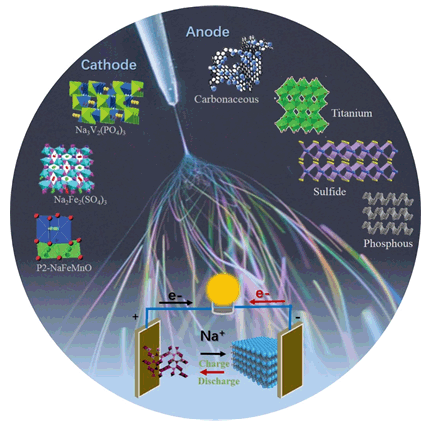摘要/Abstract

钠离子电池具有与锂离子电池相似工作机理,因其原料资源丰富,是一种极具应用前景的新一代储能设备.然而,钠离子电池面临着电极材料体积膨胀过大、钠离子传输动力学较慢和能量密度偏低等问题,阻碍了其实用化.静电纺丝技术合成的一维钠离子电池电极材料,可通过形貌调控或碳复合方式有效缓冲储钠过程中电极的体积膨胀,而且具有连续的电子传递和较短的离子传输路径,从而改善钠离子传输动力学,以提高电池倍率性能.通过电纺还可简便地制备直接用于钠离子电池的柔性纤维膜来提高电池的能量密度.综述了静电纺丝技术制备钠离子电池材料的研究进展,主要包括正极和负极材料,对今后静电纺丝在钠离子电池中的发展进行了展望.
关键词: 钠离子电池, 静电纺丝, 正极材料, 负极材料, 纳米纤维, 柔性
The scarce lithium resources would ultimately fail to satisfy the ever-growing industrial demand, especially for the large-scale stationary energy storage. Sodium-ion batteries (SIBs) are considered as promising next-generation power sources because sodium is widely available and exhibits similar chemistry to that of lithium-ion batteries (LIBs). Although sodium share similar physical and chemical properties to lithium, the lager ionic radius, heavier molar mass and less negative redox potential of Na+/Na of the sodium jointly lead to some issues beset the SIBs, such as sluggish sodiation kinetics, larger volume expansion and lower energy density, which need to be tackled to promote the practical applications of the SIBs. Therefore, developing appropriate electrode materials is crucial to achieve SIBs with long lifespan and high energy density. One-dimensional nanostructures can provide orientated electronic (ionic) transport and strong tolerance to volume change, thus enhancing the electrochemical performance of electrode materials. Electrospinning technique is a low cost and versatile method to fabricate continuous one-dimensional functional materials with various morphology and targeted components that has been widely applied in SIBs. The volume change could be buffered efficiently by facilely modifying the morphology of electrospun materials or in-situ compositing with carbon materials. Benefiting from the ultra-high aspect ratio, electrospun one-dimensional electrodes can reduce the ionic transport distance, while provide continuous transport way for electron along the longitudinal direction, which is helpful to improve the sluggish sodiation kinetics. It is also worth noting that free-standing or flexible fibers could be easily obtained via the electrospinning technique, which can be used as binder-free electrode to enhance the energy density of the batteries. The research progress on electrospun materials for sodium-ion batteries is summarized in this review, including cathode materials and anode materials. Their electrochemical performance in sodium storage is discussed in detail. The advantages and challenges of these materials were pointed out, and the future development of electrospun materials for sodium ion batteries was also prospected.
Key words: sodium-ion batteries, electrospinning, cathode materials, anode materials, nanofiber, binder-free
PDF全文下载地址:
点我下载PDF
